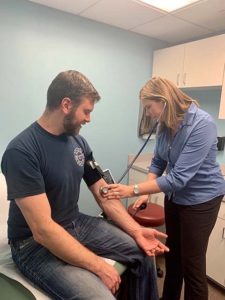High Blood Pressure (Hypertension)
According to the American Heart Association (AHA), the number of people who have high blood pressure is continuing to increase and at deadly rates. Research shows that an estimated 103 million adults in the U.S. (that’s almost half!) have high blood pressure. And worldwide, high blood pressure affects nearly a third of all adults. Furthermore, the death rate from high blood pressure has increased by 11% from 2005 to 2015. With these types of numbers, an obvious question arises for most of us, “Could I have high blood pressure? And if so, what can I do about it?”
Let’s take a look at what high blood pressure is, the symptoms and causes of high blood pressure, as well as functional treatment options that can help you live with high blood pressure without being a slave to medication.
What is High Blood Pressure?
Throughout the day, most people’s blood pressure will fluctuate depending on their activity levels and situations/exposures. Types of food and drinks consumed, along with mood (anger, fear, stress) can all impact blood pressure. This daily variance is typical in most people. However, if a person’s blood pressure (the force of your blood pushing against the walls of your blood vessels) stays at an elevated rate throughout the day, they most likely are headed into the dangerous territory of high blood pressure (HBP) also called Hypertension.
To understand high blood pressure, we must first have a basic understanding of blood pressure. Blood pressure is the result of two separate forces,1) Systolic, the heart pumping the blood through the arteries to the rest of the body, and 2) Diastolic, the rest between each heartbeat. Systolic and Diastolic may be terms you have seen before since each is represented in the numbers of a blood pressure reading (more on these numbers below).
When blood pressure has to work harder (high blood pressure) to move through the body by way of the arteries, the arteries become damaged. These tears in the artery walls are then “filled in” with LDL or bad cholesterol, which makes these passageways smaller, thus making it even more difficult for the blood to flow efficiently, resulting in a stroke, heart attack, heart failure, aneurysm, metabolic syndrome, etc.
Blood Pressure Numbers: The Good, The Bad, & The Ugly
If the last time you’ve had your blood pressure numbers checked was over six months ago, it’s time to have your blood pressure numbers re-evaluated. As previously mentioned, when you get your blood pressure checked, two numbers will be evaluated: your systolic and diastolic pressure levels. The top number is your systolic pressure, and the bottom number is the diastolic pressure. According to the American Heart Association, the following guidelines will help you to determine whether or not you have Hypertension:
- Normal: Less than 120 over 80 or less
- Elevated: 120 -129 over 80 or less
- High Blood Pressure (Stage 1 Hypertension): 130-139 over 80-89
- High Blood Pressure (Stage 2 Hypertension): 140 or higher over 90 or higher
- Hypertensive Crisis*: 180 or higher (systolic) and/or 120 or higher diastolic.
If you are taking your blood pressure at home and get a Hypertensive reading, call your doctor or 911 immediately.
Causes & Symptoms of High Blood Pressure
The biggest contributors to HBP are diet and lifestyle factors, and in some cases, genetics play a role. Many of the leading causes or contributing factors to high blood pressure include:
- Genetics (only ~ 5%)
- Age (Older people have a higher chance of developing HBP since arteries naturally stiffen as we age).
- Race (non-Hispanic black people are more likely to have high blood pressure than people of other races)
- Chronic conditions such as diabetes, high cholesterol, and hormone, and kidney problems
- Hormonal imbalances
- A high-fat diet or a diet high in salt
- Nutrient deficiencies
- Tobacco use & exposure to toxins
- Excessive alcohol consumption
- Sedentary lifestyle
- Obesity
- Stress
Known as a silent killer, high blood pressure often doesn’t present itself with a set of “usual” symptoms. However, if you do show signs of one or more of the following symptoms, or haven’t had a well-check in the last twelve months, schedule an appointment with one of our functional medicine providers today. Even if high blood pressure is not the culprit, we will work with you to uncover what is causing you to feel less than 100%.
- Constant headaches or migraines
- Insomnia, sleep apnea or difficulty sleeping
- Dizziness or light-headedness
- Nosebleeds
- Facial flushing
- Sweating
- Blood spots in eyes
- Nervousness and anxiety
Functional Medicine for High Blood Pressure
Since high blood pressure is such an epidemic in the United States, with one in three people having Hypertension, there are countless ways to “naturally lower your blood pressure” articles and “eat this to reduce your blood pressure” books and blog posts. However, unless you schedule an appointment with a functional medicine doctor to help you find out what the root cause(s) of your high blood pressure is, you may end up missing the mark entirely.
Our goal at Vitality Family Health is to equip each of our patients with a high blood pressure treatment plan that makes the most sense for them and their wellness goals. Furthermore, we take steps to empower our patients to seek alternatives to medication treatment rather than just relying solely upon medication (though medication is necessary in some cases).
With functional medicine, we want to help you create the life that you want by equipping you with the tools you need to move forward on your health journey. Some of the treatments we recommend for our hypertension patients, to control high blood pressure include:
- Diet Remediation – Unfortunately, the Standard American Diet (SAD) is sad when it comes to helping people get the optimal nutritional needs they require without too much fat, sugar, or sodium. Because of this, when high blood pressure is present, one of the first things we look into is your current diet. Foods high in sugar and sodium or refined carbohydrates triggers high blood pressure. We work with you to eliminate these foods from your diet or at least drastically reduce them if they are a current staple. Alternatively, we teach you to increase your intake of foods rich in potassium and polyphenols (think bananas, leafy greens, and berries).
- Exercise – Getting active is one of the best ways to control blood pressure, ideally 150 minutes per week. However, if you already have Hypertension or another cardiovascular disease, you must discuss an exercise regimen with your doctor that is most beneficial for your current health and will propel you into total health and wellness independence. Starting slow is always a good place to start, but we will help to make sure that you progress as your body and heart gets stronger.
- Stress Management & Coping Skills – Stress is inevitable and many times we focus on things that we have little to no control of that are occurring in our life. For this reason, our functional medicine providers help you learn how to identify the stressors you actually have control over and teach you tools to use to help you better manage stress and build resilience. Our providers also help you detoxify and purify your environment to minimize your exposure to physical stressors.
Whether or not you are experiencing symptoms of high blood pressure, it is vital to your health and wellbeing that you keep up your regular well checks with your healthcare provider in Oak Brook, IL.
Contact Vitality Family Health at your earliest convenience to schedule an appointment with one of our functional medicine providers. Let us help you take back control of your health and create the life you want to live on your terms.

